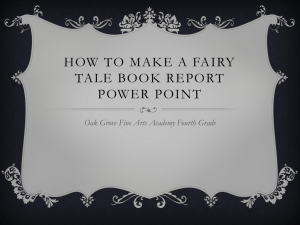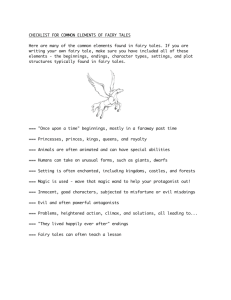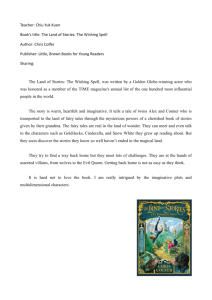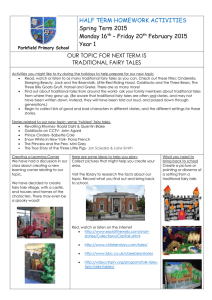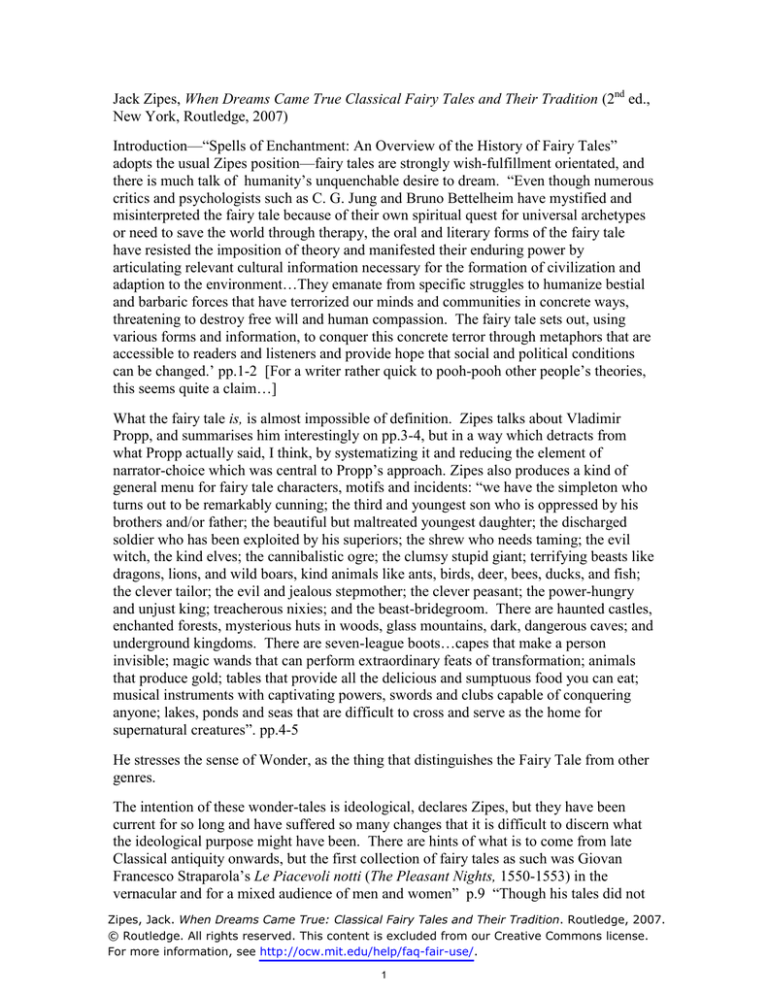
Jack Zipes, When Dreams Came True Classical Fairy Tales and Their Tradition (2nd ed.,
New York, Routledge, 2007)
Introduction—“Spells of Enchantment: An Overview of the History of Fairy Tales”
adopts the usual Zipes position—fairy tales are strongly wish-fulfillment orientated, and
there is much talk of humanity’s unquenchable desire to dream. “Even though numerous
critics and psychologists such as C. G. Jung and Bruno Bettelheim have mystified and
misinterpreted the fairy tale because of their own spiritual quest for universal archetypes
or need to save the world through therapy, the oral and literary forms of the fairy tale
have resisted the imposition of theory and manifested their enduring power by
articulating relevant cultural information necessary for the formation of civilization and
adaption to the environment…They emanate from specific struggles to humanize bestial
and barbaric forces that have terrorized our minds and communities in concrete ways,
threatening to destroy free will and human compassion. The fairy tale sets out, using
various forms and information, to conquer this concrete terror through metaphors that are
accessible to readers and listeners and provide hope that social and political conditions
can be changed.’ pp.1-2 [For a writer rather quick to pooh-pooh other people’s theories,
this seems quite a claim…]
What the fairy tale is, is almost impossible of definition. Zipes talks about Vladimir
Propp, and summarises him interestingly on pp.3-4, but in a way which detracts from
what Propp actually said, I think, by systematizing it and reducing the element of
narrator-choice which was central to Propp’s approach. Zipes also produces a kind of
general menu for fairy tale characters, motifs and incidents: “we have the simpleton who
turns out to be remarkably cunning; the third and youngest son who is oppressed by his
brothers and/or father; the beautiful but maltreated youngest daughter; the discharged
soldier who has been exploited by his superiors; the shrew who needs taming; the evil
witch, the kind elves; the cannibalistic ogre; the clumsy stupid giant; terrifying beasts like
dragons, lions, and wild boars, kind animals like ants, birds, deer, bees, ducks, and fish;
the clever tailor; the evil and jealous stepmother; the clever peasant; the power-hungry
and unjust king; treacherous nixies; and the beast-bridegroom. There are haunted castles,
enchanted forests, mysterious huts in woods, glass mountains, dark, dangerous caves; and
underground kingdoms. There are seven-league boots…capes that make a person
invisible; magic wands that can perform extraordinary feats of transformation; animals
that produce gold; tables that provide all the delicious and sumptuous food you can eat;
musical instruments with captivating powers, swords and clubs capable of conquering
anyone; lakes, ponds and seas that are difficult to cross and serve as the home for
supernatural creatures”. pp.4-5
He stresses the sense of Wonder, as the thing that distinguishes the Fairy Tale from other
genres.
The intention of these wonder-tales is ideological, declares Zipes, but they have been
current for so long and have suffered so many changes that it is difficult to discern what
the ideological purpose might have been. There are hints of what is to come from late
Classical antiquity onwards, but the first collection of fairy tales as such was Giovan
Francesco Straparola’s Le Piacevoli notti (The Pleasant Nights, 1550-1553) in the
vernacular and for a mixed audience of men and women” p.9 “Though his tales did not
Zipes, Jack. :KHQ'UHDPV&DPH7UXH&ODVVLFDO)DLU\7DOHVDQG7KHLU7UDGLWLRQ. Routledge, 2007.
© Routledge. All rights reserved. This content is excluded from our Creative Commons license.
For more information, see http://ocw.mit.edu/help/faq-fair-use/.
1
achieve the popularity of Boccaccio’s collection, they were reprinted several times in
Italian during the next few centuries and were translated into French in the eighteenth
century and German and English in the nineteenth century”. p.9 Giambattista Basile’s
Lo Cunto de li cunti, also called The Pentameron, published posthumously in 1634,
written in the Neapolitan dialect. “Although it cannot be fully documented, it is highly
likely that the Italian literary fairy tales were gradually spread in print and by word of
mouth throughout Europe.” pp.11-12. Then we turn to the French, Mme d’Aulnoy and
Charles Perrault who bring us the contes de fée. Perrault seems to have been responsible
for the first published versions of Cinderella, Little Red Riding Hood, Sleeping Beauty,
Blue Beard and Tom Thumb. A French version of The Thousand and One Nights (170417) was published in the early years of the eighteenth century. Zipes offers a seemingly
entirely conjectural account of the reason for the predominance of female writers in this
phase of the French tradition, it is that they were advocating a non-Christian notion of the
supernatural in reaction to the persecution of female witches during the previous two
centuries. Fairytales also circulated in 18th century France as chapbooks, the so-called
Blbliothèque Bleue, very popular with the common people and children. During the
eighteenth century also, literary fairy stories began to be written with a view to
socialising children into acceptable social beliefs and conduct. This culminated with
Charles Mayer’s Le Cabinet des Fées published between 1785-1789 in 41 volumes.
German writers too “began employing the fairy tale to celebrate German customs.” p.18
Zipes mentions Musäus, Wieland and others in this respect, culminating in the Grimms.
With the German Romantics, the Fairy Tale became even more strongly a criticism of the
prevailing ethos and was aimed really at adults. But at the same time the Grimms in their
successive revisions edited down the tales more and more for children. The Grimms were
translated into English by Edgar Taylor with illustrations by Cruikshank under the title
German Popular Stories in 1823. Andersen “more than any writer of the nineteenth
century...fully developed what Perrault had begun, to write tales such as ‘The Ugly
Duckling’ and ‘The Red Shoes’ which could be readily grasped by children and adults
alike but with a different understanding. Really, no sooner had an Fairy Tale canon
developed than people began to distort and subvert it, as a means of questioning the
conventional morality of the time which the more didactic tales seemed inclined to foster.
[Maybe Disney is slightly different here—he uses the Fairy Tale tradition to affirm and
reinforce the conventional morality of the time?] Amongst these revisionists he mentions
George MacDonald (“The Day Boy and the Night Girl” 1879) and Oscar Wilde (“The
Fisherman and his Soul’”1891) and Robert Louis Stevenson (“The Bottle Imp”). Lewis
Carroll’s Alice also comes into this and had a major influence […] the most notable
American fairy tale of the nineteenth century was L. Frank Baum’s The Wonderful
Wizard of Oz (1900), which depicts Dorothy’s great desire to break out of Kansas and
determine her own destiny, a theme that Baum also explored in “The Queen of Quok” in
American Fairy Tales (1901) p.22 By the early 20th century Fairy Tale themes could be
found in drama, poetry, ballet, music and opera. Zipes claims The Magic Flute as an
example of this. He mentions the extreme politicisation of the Fairy Tales under the
Nazis (but gives no references). Amongst post-war writers he mentions Philip K. Dick’s
“The King of the Elves” (1953), Naomi Mitchison’s “Five Men and a Swan” (1957) and
Sylvia Townsend Warner, “Bluebeard’s Daughter” (1960). The list is fairly extensive:
what bound them together is that “they know that most of their readers have been
Zipes, Jack. :KHQ'UHDPV&DPH7UXH&ODVVLFDO)DLU\7DOHVDQG7KHLU7UDGLWLRQ. Routledge, 2007.
© Routledge. All rights reserved. This content is excluded from our Creative Commons license.
For more information, see http://ocw.mit.edu/help/faq-fair-use/.
2
‘Disneyfied,’ that is, they have been subjected to the saccharine, sexist, and illusionary
stereotypes of the Disney-culture [sic] industry.’ p.15 “Perhaps the major social critique
carried by the Fairy Tale can be seen in the restructuring, the reformation of the fairy tale
itself as genre, on the part of feminists. The result has been a remarkable production of
nonsexist fairy tales for children and adults, as well as theoretical works that explore the
underlying implications of gender roles in fairy tales.” p.25. Mentions Anne Sexton,
Angela Carter, Olga Broumas, Margaret Atwood, A. S. Byatt, Tanith Lee, Rosemarie
Kunzler, Jane Yolen and Robin McKinley who have “created highly innovative tales that
reverse and question traditional sex roles…[they] have reacted critically to the standard
canon representing catatonic females flat on their backs waiting to be brought to life by
charming princes. A good example is the work of Attic Press in Ireland, which has
published such books as Rapunzel’s Revenge (1985), Cinderella on the Ball (1991), and
Ride on Rapunzel (1992). In similar vein but with Fairy Tales much more diverse, Ellen
Datlow and Terri Windling have published a series of important fairy-tale anthologies:
Black Thorn, White Rose (1993), Snow White, Blood Red (1994) Ruby Slippers, Golden
Tears (1995), and Black Swan, White Raven (1997). These books contain original stories
by such notable writers as Joyce Carol Oates, John Crowey, Nancy Kress, Lisa Goldstein,
Tanith Lee, and Gene Wolfe that break the parameters of the classical fairy tale and
explore the genre’s potential to address contemporary social concerns.” pp.25-6. Zipes
dismisses most fairy tale films as socially and morally conservative conformist slush, but
praises a few more recent ones including, interestingly: “Andy Tennant’s Ever After
(1998), a cinematic adaptation of Charles Perrault’s famous fairy tale ‘Cinderella’, uses a
clever conceit to catch our attention. Jacob and Wilhelm Grimm arrive at the castle of a
French aristocratic woman played by the majestic Jeanne Moreau, and after she shows
them a glittering glass slipper, she invited them to spend a few hours with her while she
regales them with the true story of Cinderella, who was ostensibly her grandmother. As
she tells her story, the Grimms are dazzled, for at the end of it, they realize that Charles
Perrault’s version was based on historical fact and that they had perpetuated a lie through
their own particular version. Indeed, they learn that Cinderella, played by the pugnacious
Drew Barrymore, was a liberal feminist before her times. She read Thomas More’s
Utopia , defended the rights of bonded servants, advocated educational and social
reforms, enchanted a prince as well as Michelangelo, and became the queen of France.
When the Grimms leave the castle, we smile because we are part of an inside joke and, at
the same time, we wish that Tenant’s fraudulent version of ‘Cinderella’ might really be
true, just as we wish that utopian aspects of the fairy tale were less commodified than
they are in the Disney tradition.” pp.27-8.
Zipes claims that the Shrek movies are subversive of the Disney ethos. “In the first film
all the fairy-tale characters from the Grimms’ tales up through the Disney films are
banished to Shrek’s swamp. There they are happy and find refuge from the brutal
puritanical force of Lord Farquaad, who resembles Michael Eisner, the former head of
the Disney Corporation […] What is neat, clean, and beautiful at his court, which
resembles the antiseptic Disneyland, masks the violence and ugliness of Farquaad’s
empire…” p.29 The second episode also exposes the blackmail and pretension and force
upon which the “official” world lives and most of the characters are happy to live in the
swamp and be marginalised. [But isn’t Pixar itself part of the Disney empire?]
Zipes, Jack. :KHQ'UHDPV&DPH7UXH&ODVVLFDO)DLU\7DOHVDQG7KHLU7UDGLWLRQ. Routledge, 2007.
© Routledge. All rights reserved. This content is excluded from our Creative Commons license.
For more information, see http://ocw.mit.edu/help/faq-fair-use/.
3
MIT OpenCourseWare
http://ocw.mit.edu
21L.430 / CMS.920 Popular Culture and Narrative: Use and Abuse of the Fairy Tale
Fall 2015
For information about citing these materials or our Terms of Use, visit: http://ocw.mit.edu/terms.

